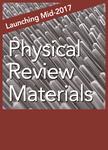版权所有:内蒙古大学图书馆 技术提供:维普资讯• 智图
内蒙古自治区呼和浩特市赛罕区大学西街235号 邮编: 010021

作者机构:Macromolecular Science and Engineering Program University of Michigan Ann Arbor Michigan 48109 USA Department of Chemical Engineering University of Michigan Ann Arbor Michigan 48109 USA Department of Physics University of Michigan Ann Arbor Michigan 48104 USA Department of Materials Science and Engineering University of Michigan Ann Arbor Michigan 48109 USA Biointerfaces Institute University of Michigan Ann Arbor Michigan 48109 USA
出 版 物:《Physical Review Materials》 (Physic. Rev. Mat.)
年 卷 期:2018年第2卷第12期
页 面:125201-125201页
核心收录:
基 金:C-PHOM Center for Photonic and Multiscale Nanomaterials National Science Foundation Materials Research Science and Engineering Center, (DMR 1120923) National Science Foundation, NSF, (1053575, 1120923, 1256260, DGE 1256260) National Science Foundation, NSF Simons Foundation, SF Horace H. Rackham School of Graduate Studies, University of Michigan, Rackham U-M University of Michigan, U-M
主 题:Photonic crystals Colloidal crystal Hard sphere colloids
摘 要:Materials adopting the diamond structure possess useful properties in atomic and colloidal systems and are a popular target for synthesis in colloids where a photonic band gap is possible. The desirable photonic properties of the diamond structure pose an interesting opportunity for reconfigurable matter: Can we create a crystal able to switch reversibly to and from the diamond structure with a photonic band gap in the visible light range? Drawing inspiration from high-pressure transitions of diamond-forming atomic systems, we design a system of polyhedrally shaped colloidal particles with spherical cores that transitions from diamond to a tetragonal diamond derivative upon a small pressure change. The transition can alternatively be triggered by changing the shape of the particle in situ. We propose that the transition provides a reversible reconfiguration process for a potential new colloidal material and draw parallels between this transition and the phase behavior of the atomic transitions from which we take inspiration.